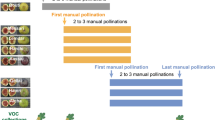Abstract
Each fig tree species (Ficus) is totally dependent on a specific species of wasp for pollination and the larvae of these wasps only develop in the ovules of their specificFicus host. Because the fig crop on any particular tree is generally highly synchronized, the shortlived female wasps must leave their natal tree in order to find figs which are suitable for oviposition. Chemical volatiles produced by figs when they are ready for pollination are thought to be the means by which the wasps detect a suitable host. Gas chromatograms of the fig volatiles of 7 species ofFicus showed them to be species specific. Age related changes in the volatile profiles were noted as extra volatiles are produced when the figs were ready for pollination.
Similar content being viewed by others
References
Barker, N. P., 1985: Evidence of a volatile attractant inF. ingens (Moraceae). — Bothalia15: 607–611.
Berg, C. C., 1988: Classification and distribution ofFicus. — Experientia45: 605–611.
Borg-Karlson, A.-K., Bergström, G., Groth, I., 1985: Chemical basis for the relationship betweenOphrys orchids and their pollinators 1. Volatile compounds ofOphrys lutea andO. fusca as insect mimetic attractants/excitants. — Chem. Scrip.25: 283–294.
Bouček, Z., 1988: AustralianChalcidoidea (Hymenoptera). — Wallingford, Oxon: C.A.B. International.
Bronstein, J. L., 1987: Maintenance of species-specificity in a neotropical fig—pollinating wasp mutualism. — Oikos48: 39–46.
Buttery, R. G., Flath, R. A., Mon, T. R., Ling, L. C., 1986: Identification of germacrene D in walnut and fig leaf volatiles. — J. Agric. Food. Chem.34: 820–822.
Galil, J., 1977: Fig biology. — Endeavour1: 51–56.
, 1968: Flowering cycles and fruit types ofFicus sycomorus in Israel. — New Phytol.67: 745–758.
, 1973: Topocentric and ethnodynamic pollination. — InBronjes, N. B. M., Linskens, H. F., (Eds): Pollination and dispersion, pp. 85–100. — Nijmegen, Netherlands: Department of Botany, University Nijmegen.
Hills, H. G., Williams, N. H., Dobson, C. H., 1972: Floral fragrances and isolating mechanisms in the genusCatasetum (Orchidaceae). — Biotropica4: 61–76.
Janzen, D. H., 1979: How to be a fig. — Ann. Rev. Ecol. Syst.10: 13–51.
Jennings, W. G., 1977: Volatile components of figs. — Food Chem.2: 185–191.
Kjellberg, F., Doumeshe, D., Bronstein, J. L., 1988: Longevity of a fig wasp (Blastophaga psenes). — Proc. Kon. Ned. Akad. Wetensch. C91: 117–122.
MacKay, D. A., Jones, R. E., 1989: Leaf shape and host-finding behaviour of two ovipositing monophagous butterfly species. — Ecol. Entomol.14: 423–431.
Michaloud, G., Michaloud-Pelletier, S., Wiebes, J. T., Berg, C. C., 1985: The cooccurrence of two species of fig wasp and one species of fig. — Proc. Kon. Ned. Akad. Wetensch. C88: 93–119.
Murlis, J., Elkinton, J. S., Cardé, R. T., 1992: Odor plumes and how insects use them. — Ann. Rev. Ent.37: 505–532.
Owens, E. D., Prokopy, R. J., 1986: Relationship between reflectance spectra of host plant surfaces and visual detection of host fruit byRhagoletis pomonella. — Physiol. Entomol.11: 297–307.
Pellmyr, O., Thien, L. B., 1986: Insect reproduction and floral fragrances: keys to the evolution of the angiosperms. — Taxon35: 76–85.
Ramirez, B. W., 1970: Host specificity of fig wasps (Agaonidae). — Evolution24: 681–691.
, 1974: Co-evolution ofFicus andAgaonidae. — Ann. Missouri Bot. Gard.61: 770–780.
Rausher, M. D., 1978: Search image for leaf shape in a butterfly. — Science200: 1071–1073.
Tabashnik, B. E., 1985: Deterrence of diamondback moth (Lepidoptera: Plutellidae) oviposition by plant compounds. — Environ. Entomol.14: 575–578.
Van Noort, S., Ware, A. B., Compton, S. G., 1989: Pollinator-specific volatile attractants released from the figs ofFicus burtt-davyi. — S African J. Sci.85: 323–324.
Visser, J. H., 1986: Host odor perception in phytophagous insects. — Ann. Rev. Entomol.31: 121–144.
Ware, A. B., Compton, S. G., 1992: Breakdown of pollinator specificity in an African fig tree. — Biotropica24: 544–549.
Warthen, J. D., McInnes, D. O., 1989: Isolation and identification of male medfly attractive components inLichi chinensis stems andFicus spp. stem exudates. — J. Chem. Ecol.15: 1931–1946.
Wiebes, J. T., 1979: Co-evolution of figs and their insect pollinators. — Ann. Rev. Ecol. Syst.10: 1–12.
, 1990:Agaonidae (Hymenoptera Chalcidoidea) andFicus (Moraceae): fig wasps and their figs, VI (Africa concluded). — Proc. Kon. Ned. Akad. Wetensch.93: 203–222.
Author information
Authors and Affiliations
Rights and permissions
About this article
Cite this article
Ware, A.B., Kaye, P.T., Compton, S.G. et al. Fig volatiles: Their role in attracting pollinators and maintaining pollinator specificity. Pl Syst Evol 186, 147–156 (1993). https://doi.org/10.1007/BF00940794
Received:
Revised:
Accepted:
Issue Date:
DOI: https://doi.org/10.1007/BF00940794




